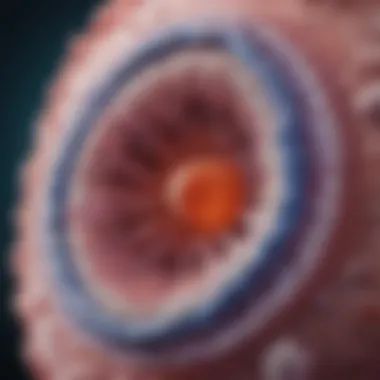Eosinophilic Esophagitis: A Comprehensive Examination


Intro
Eosinophilic esophagitis (EoE) is an increasingly recognized condition affecting a significant number of individuals, marked by eosinophil accumulation in the esophagus. This immune-mediated disease often leads to various symptoms that can significantly affect quality of life. Understanding EoE requires a multifaceted approach, encompassing causes, symptoms, and potential treatment strategies. The complexity surrounding EoE makes it an important focus for researchers and healthcare providers alike, requesting a deeper examination of its mechanisms, symptoms, and treatment options.
Article Overview
Purpose of the Article
The purpose of this article is to provide a detailed analysis of eosinophilic esophagitis. This includes looking into its etiology, the clinical symptoms, and various methods of diagnosis and treatment. The aim is to equip readers with a deeper understanding of the complexities linked to EoE. Knowledge is essential for both professionals in the field and those directly affected by the condition.
Relevance to Multiple Disciplines
Eosinophilic esophagitis resonates across various fields, such as:
- Gastroenterology: Key for understanding gastrointestinal disorders.
- Immunology: Provides insights into immune response mechanisms.
- Nutrition: Highlights the dietary influences impacting EoE.
- Public Health: Emphasizes the increasing prevalence and need for awareness.
Recognizing its multidimensional relevance aids in fostering collaboration among specialists aiming to enhance patient outcomes.
Research Background
Historical Context
The understanding of eosinophilic esophagitis has significantly evolved over the past few decades. Initially, cases were often misdiagnosed or overlooked. Advancements in medical technology and increased awareness among healthcare providers have led to a more accurate understanding of the disease.
Key Concepts and Definitions
To grasp eosinophilic esophagitis fully, several key terms and concepts must be defined:
- Eosinophils: White blood cells that play a vital role in the immune response and are often involved in allergic reactions.
- Immune-mediated condition: A disease where the immune system mistakenly attacks the body’s own tissues.
- Dysphagia: A medical term describing difficulty in swallowing, often seen in patients with EoE.
These concepts serve as a foundation for understanding the complexities of eosinophilic esophagitis.
"Understanding eosinophilic esophagitis not only aids in better diagnosis but significantly improves management strategies for affected individuals."
"Understanding eosinophilic esophagitis not only aids in better diagnosis but significantly improves management strategies for affected individuals."
Prelude to Eosinophilic Esophagitis
Eosinophilic esophagitis (EoE) is gaining recognition as a significant condition affecting the esophagus. This section lays the groundwork for understanding EoE by exploring its definition, implications, and historical context. An in-depth understanding of EoE is essential for various stakeholders, including clinicians, patients, and researchers.
EoE is not just another esophageal condition; it poses unique diagnostic and therapeutic challenges. The importance of this topic cannot be overstated, given the rising prevalence of EoE in the general population and its substantial impact on quality of life. By examining the topic comprehensively, readers will gain insights into its complexities and their relevance to patient care.
Definition and Overview
Eosinophilic esophagitis is an immune-mediated esophageal condition characterized by an excessive infiltration of eosinophils, a type of white blood cell. These eosinophils accumulate in the esophageal tissue, leading to inflammation and, potentially, damage. This infiltration typically occurs in response to certain allergens and triggers, which can range from food components to environmental factors.
The clinical presentation of EoE varies widely among individuals. Most commonly, symptoms include difficulty swallowing, persistent heartburn, and food impactions. Notably, EoE is diagnosed primarily through endoscopic biopsy, where eosinophils are identified in the esophageal tissue.
Historical Context
The recognition of eosinophilic esophagitis as a distinct clinical entity is relatively recent. First described in medical literature in the early 1990s, it was sometimes misdiagnosed as gastroesophageal reflux disease (GERD). This overlap led to numerous patients receiving inappropriate treatments for years, underlining the importance of accurate diagnosis.
Since its discovery, there has been a surge of interest in EoE, with increased research funding and clinical trials focused on understanding its pathophysiology and refining treatment options. The role of genetics, dietary triggers, and environmental factors are now central themes in ongoing investigations.
With its evolving landscape and growing recognition, eosinophilic esophagitis has become a critical area of study within gastroenterology. Understanding the condition's history enhances our appreciation for current research and treatment approaches.
Epidemiology of Eosinophilic Esophagitis
Understanding the epidemiology of eosinophilic esophagitis (EoE) is crucial for several reasons. First, it sheds light on the scope and impact of this increasingly recognized condition. The prevalence and incidence rates of EoE have notably risen over the last few decades, indicating a need for greater awareness within the medical community.
Epidemiological studies help identify at-risk populations, which can guide early diagnosis and management strategies. Recognizing demographic trends also aids in understanding how social factors and environmental influences may interact with genetic predispositions.
Prevalence and Incidence
Recent data suggest that EoE is becoming more common, affecting approximately 1 in 2,000 individuals in the general population. Some studies show even higher figures, indicating that many cases may go undiagnosed or misdiagnosed. The annual incidence has risen significantly, particularly in regions like North America and Europe where awareness is increasing.
A common finding is the increase in EoE diagnosis rates in children and young adults, hinting that onset at an early age may contribute to the overall higher prevalence.
"Early diagnosis is essential to manage eosinophilic esophagitis effectively, and understanding its epidemiology is the first step toward that goal."


"Early diagnosis is essential to manage eosinophilic esophagitis effectively, and understanding its epidemiology is the first step toward that goal."
A few estimates suggest that the number of cases may be even greater due to underreporting. EoE can be mistaken for gastroesophageal reflux disease (GERD) or other conditions, leading to a significant diagnostic delay among patients.
Demographic Considerations
Eosinophilic esophagitis has demonstrated variable incidence across different demographic groups. Typically, males are more frequently diagnosed than females, with the ratio ranging around 3:1. This male predominance may have biological roots related to immune system differences.
Age is another important factor in the epidemiology of EoE. The condition is most commonly diagnosed in children, but adults have increasingly become part of the demographic profile over recent years. Its manifestation in adults can present differently, sometimes leading to confusion in diagnosis.
Ethnic and racial differences also appear in the context of EoE. Higher prevalence rates have been reported in Caucasian populations. However, as studies evolve, it is essential to gather more comprehensive data to understand how ethnicity influences the occurrence and presentation of EoE.
Both socio-economic status and environmental issues can play a crucial role in the epidemiology of EoE as well. Individuals living in urban areas with higher pollution levels may exhibit different incidence rates compared to rural populations.
In summary, the epidemiology of eosinophilic esophagitis reveals a complex interplay between genetics, environment, and immune response. It underscores the need for healthcare professionals to remain vigilant, particularly as awareness of this condition continues to evolve.
Pathophysiology of Eosinophilic Esophagitis
Understanding the pathophysiology of eosinophilic esophagitis (EoE) is crucial. It provides insight into the mechanisms driving this condition. EoE is characterized by an abnormal immune response within the esophagus. This results in inflammation and the accumulation of eosinophils, a type of white blood cell. These cells can lead to tissue damage and the symptoms associated with EoE.
The immune response in EoE is notably intricate. Various factors such as allergens, genetic predispositions, and environmental influences contribute to it. Grasping these details enhances the comprehension of its clinical ramifications and potential therapeutic avenues.
Immune Response Mechanisms
The immune response mechanisms in EoE predominantly involve types of immune cells, particularly T-helper type 2 (T) cells. These cells become activated in response to allergens. In EoE, this leads to the overproduction of specific cytokines, like interleukin-4 and interleukin-13. These cytokines are pivotal. They recruit eosinophils to the esophageal tissue, driving chronic inflammation.
The role of eosinophils extends beyond mere accumulation. They release various mediators that can exacerbate inflammation and tissue damage. This cycle of recruitment and activation sustains the pathological process. In particular, mast cells also play a significant role, as they can further amplify the T response, complicating the immune landscape.
- Key Points of immune response mechanisms include:
- Activation of T cells by environmental allergens.
- Overproduction of cytokines leading to eosinophil recruitment.
- Sustaining inflammation through eosinophil mediators.
Role of Eosinophils
Eosinophils are central to the pathophysiology of EoE. Their primary role is to respond to allergens and parasites. In EoE, eosinophils become inappropriately activated, leading to excessive inflammation. They migrate to the esophagus causing the characteristic symptoms of EoE such as dysphagia and food impaction.
Eosinophils encapsulate granules filled with toxic proteins. When these granules are released, they can lead to damage of the esophageal epithelium. This damage is not just a consequence, but also a contributor to the ongoing inflammatory process. Eosinophilic infiltration poses risks for complications, including fibrosis and narrowing of the esophagus.
The presence of eosinophils in the esophageal tissue can be observed during biopsies, confirming the diagnosis of EoE. Thus, targeting eosinophils and modulating their activity holds potential as a therapeutic strategy. Ongoing studies are particularly interested in medications that inhibit various aspects of the T immune response, potentially reducing eosinophilic accumulation.
The role of eosinophils extends beyond their presence in tissue; they actively contribute to the mechanics of inflammation in eosinophilic esophagitis.
The role of eosinophils extends beyond their presence in tissue; they actively contribute to the mechanics of inflammation in eosinophilic esophagitis.
Understanding the intricate relationship between immune response mechanisms and the role of eosinophils is essential in both diagnosis and therapeutic approaches. By delineating the pathophysiological aspects of EoE, healthcare providers and researchers can better engage in effective treatment strategies.
Clinical Presentation
The clinical presentation of eosinophilic esophagitis (EoE) is crucial in both recognition and management of the condition. Understanding the symptoms and associated signs helps clinicians differentiate EoE from other similar esophageal disorders. The nature of symptoms can significantly impact quality of life. For patients, timely recognition of these symptoms leads to earlier diagnosis and treatment, thus enhancing their overall well-being.
Symptoms and Signs
The symptoms of EoE can vary widely among individuals, often resulting in challenges for diagnosis. Typical symptoms include:
- Dysphagia: Difficulty swallowing is a hallmark symptom. Patients may experience food getting stuck in the esophagus, leading to discomfort or pain.
- Odynophagia: Painful swallowing can occur, which some individuals may confuse with a sore throat.
- Chest Pain: Non-cardiac chest pain is common in EoE, often leading to misdiagnosis.
- Acid Reflux Symptoms: Patients might present with heartburn, though standard acid-reducing medications may not provide relief.
- Food Impaction: In severe cases, food may become lodged in the esophagus, requiring emergency intervention.
- Nausea and Vomiting: These symptoms can also arise, further complicating the patient’s experience.
EoE is often incorrectly characterized due to its overlap with gastroesophageal reflux disease (GERD). This can delay appropriate treatment, making it essential for clinicians to be vigilant for EoE when patients exhibit these nonspecific symptoms.
Differential Diagnosis
Differential diagnosis is a vital component when evaluating a patient for eosinophilic esophagitis. Clinicians must consider a range of conditions that may mimic EoE's presentation, including:
- Gastroesophageal Reflux Disease (GERD): Typically presents with similar symptoms, making misdiagnosis frequent.
- Achalasia: Characterized by esophageal dysmotility; symptoms may overlap with those of EoE.
- Esophageal Rings and Strictures: These structural abnormalities can produce dysphagia.
- Esophagitis of Various Etiologies: Conditions such as infectious esophagitis or drug-induced esophagitis can present with overlapping symptoms.
"A detailed clinical history and targeted diagnostic tests are crucial for accurately distinguishing EoE from other esophageal conditions."
"A detailed clinical history and targeted diagnostic tests are crucial for accurately distinguishing EoE from other esophageal conditions."
In practice, a combination of patient history, endoscopy, and histological evaluations is often utilized to arrive at an accurate diagnosis. Culture and serological tests may further assist in ruling out alternative diagnoses.
In summary, understanding the clinical presentation of EoE is fundamental for effective management. Clear recognition of symptoms and thorough differential diagnosis can ultimately improve patient outcomes and streamline treatment approaches.


Diagnostic Approaches
Understanding the diagnostic approaches for eosinophilic esophagitis (EoE) is essential for accurate identification and management of this complex condition. Early detection significantly improves patient outcomes, leading to timely therapeutic interventions, which can reduce morbidity associated with EoE. Diagnostic methods serve not only to confirm the diagnosis but also to guide treatment strategies, making them a critical focus of any comprehensive examination of EoE.
Key diagnostic approaches include endoscopic findings, histological evaluation, and serological tests. Each method has distinct characteristics, strengths, and limitations. Therefore, a well-rounded understanding of these approaches is crucial for healthcare professionals involved in diagnosing and treating patients with EoE.
Endoscopic Findings
Endoscopy plays a crucial role in diagnosing EoE. During this procedure, a thin, flexible tube with a camera is inserted through the mouth to view the esophagus. The direct visualization provides invaluable insights into the physical state of the esophagus.
Common endoscopic findings that point toward EoE include:
- Isolated rings
- Furrows
- White specks or patches
- Strictures
These findings may help to differentiate EoE from other esophageal conditions, such as gastroesophageal reflux disease (GERD). However, endoscopy alone cannot confirm EoE; it must be complemented by histological examination to assess eosinophil counts in the tissue.
Histological Evaluation
Histological evaluation remains a cornerstone in the diagnosis of EoE. This involves taking biopsies of the esophageal lining during endoscopy. The biopsies are then analyzed under a microscope to evaluate eosinophil counts.
A diagnosis of EoE is typically considered when there are more than 15 eosinophils per high-power field in the esophageal mucosa. However, histological findings must correlate with clinical symptoms and endoscopic appearances for a conclusive diagnosis. The importance of histological evaluation lies in its ability to provide a clear understanding of the inflammatory process occurring within the esophagus, guiding both the diagnosis and subsequent management.
Serological Tests
Serological tests are emerging as a useful adjunct in the diagnostic process for EoE. These tests often measure specific markers in the blood that may indicate allergic responses or immune dysfunction related to EoE. Biomarkers, such as eosinophil cationic protein, can provide supplemental data, although they are not definitive for diagnosis.
Commonly performed serological tests may include:
- Total IgE levels
- Specific allergen panel
- Eosinophil counts
Although serological tests are not sufficient on their own, they can help in assessing potential triggers of EoE and can ease the decision-making process regarding treatment options, particularly for dietary management.
It is vital for healthcare providers to utilize a combination of these diagnostic approaches to create a complete picture of the patient’s condition, as no single test can definitively diagnose EoE.
It is vital for healthcare providers to utilize a combination of these diagnostic approaches to create a complete picture of the patient’s condition, as no single test can definitively diagnose EoE.
Management Strategies
Management strategies for eosinophilic esophagitis (EoE) are vital for maintaining patients' long-term well-being. Addressing EoE involves a multifaceted approach that combines pharmacological treatments, dietary management, and possible endoscopic interventions. Each treatment option can significantly impact symptoms and quality of life. The effectiveness of these strategies varies according to individual patient needs, making personalized treatment plans essential.
Pharmacological Treatments
Pharmacological treatments are often the first line of defense against EoE. These medications help reduce eosinophil counts in the esophagus and alleviate symptoms. The three main categories include topical corticosteroids, systemic corticosteroids, and amino acid-based formulas.
Topical Corticosteroids
Topical corticosteroids, such as budesonide, are often compounded into a slurry that patients swallow. Their primary role is to reduce inflammation and eosinophil infiltration in the esophagus. They are considered a beneficial choice because they target inflammation directly at the site, limiting systemic side effects.
One key characteristic is their localized effect. This feature means that while they are effective for reducing immediate symptoms, they may take some time to show full benefits. A downside can include potential thrush when not rinsed from the mouth after taking.
Systemic Corticosteroids
Systemic corticosteroids, like prednisone, can also effectively manage EoE but are generally reserved for severe cases. They work by broadly suppressing the immune response. They are useful in acute exacerbations but come with a higher risk of side effects, including weight gain, bone density loss, and increased risk of infection.
The unique feature of systemic corticosteroids is their rapid onset of action, often providing quick symptom relief. However, their long-term use raises concerns, which makes them less ideal for chronic management.
Amino Acid-Based Formula
Amino acid-based formulas are a specialized option for patients, particularly children, with food allergies contributing to EoE. This formula is free from potential allergens, which helps in identifying triggers. Their primary characteristic is that they are hypoallergenic and can serve as a sole source of nutrition in some cases.
A major advantage of amino acid-based formulas is their ability to promote esophageal healing while eliminating symptomatic food allergens. Still, this option may not provide all essential nutrients, requiring careful monitoring.
Dietary Management
Dietary management plays a significant role in treating EoE. Specific dietary plans can help patients avoid triggers and minimize symptoms. Two primary options include elimination diets and elemental diets.
Elimination Diets
Elimination diets focus on removing known allergens from the patients' diets. This approach identifies specific food triggers responsible for eosinophilic inflammation. A key characteristic is its adaptability; patients can manage their diet based on their allergies.
This diet is beneficial because it allows the patient to still consume a varied diet once triggers are removed. However, it requires meticulous planning to ensure that nutritional needs are met.


Elemental Diets
Elemental diets consist of pre-digested amino acids, which minimize allergic reactions. They are often used for a defined period to assist in controlling symptoms. The primary characteristic of elemental diets is their simplicity, as they eliminate almost all allergens from the diet temporarily.
An advantage is that they tend to induce rapid healing of the esophagus. However, the restrictive nature of these diets can lead to nutritional deficiencies if not carefully supervised and is often not well tolerated by older children or adults.
Endoscopic Interventions
Endoscopic interventions may be necessary for severe cases of EoE that do not respond to medical management. They can help in alleviating symptoms or identifying complications related to the condition.
"A comprehensive management strategy that includes both pharmacological treatments and dietary modifications can significantly improve life for individuals with eosinophilic esophagitis."
"A comprehensive management strategy that includes both pharmacological treatments and dietary modifications can significantly improve life for individuals with eosinophilic esophagitis."
Living with Eosinophilic Esophagitis
Living with eosinophilic esophagitis (EoE) can pose significant challenges for individuals affected by this condition. It is crucial to consider the multifaceted aspects of life that EoE impacts, including emotional well-being, social interactions, and daily routines. Understanding these elements is essential for both patients and caregivers, as it fosters a comprehensive management approach that takes into account not just the physical symptoms but also the psychosocial implications.
Psychosocial Impact
EoE is not merely a medical condition; it heavily influences the psychological and social aspects of life. Many individuals may experience feelings of anxiety or depression related to their symptoms. The chronic nature of the condition can lead to frustration, particularly when dealing with dietary restrictions and the unpredictability of flare-ups. Patients often find themselves navigating a world where eating out, attending social gatherings, or simply enjoying common foods becomes complicated.
The emotional toll can be heightened by the need for continuous medical follow-up and potential treatments. Patients might feel isolated, as people around them may not understand their struggles. Support groups and patient communities can provide critical platforms for sharing experiences, fostering a sense of belonging, and obtaining emotional support.
"Understanding the emotional landscape of living with EoE can empower patients to manage their condition more effectively."
"Understanding the emotional landscape of living with EoE can empower patients to manage their condition more effectively."
Patient Education and Support
Education is one of the most effective tools for managing EoE. Patients and their families must be well-informed about the nature of the disease, its triggers, and the available treatment options. Knowledge about dietary modifications, symptom management, and potential complications can significantly enhance the quality of life.
Support resources are equally important. Healthcare providers, nutritionists, and patient organizations can offer vital insights and strategies for coping. This may include:
- Guidance on identifying and avoiding food triggers.
- Recommendations for meal planning and preparation.
- Psychological support through therapy or counseling.
Furthermore, many find sharing their stories and experiences with others facing similar challenges to be beneficial. Online forums, like those found on Reddit, can serve as platforms for patient interaction and information exchange. Social media groups on platforms such as Facebook can also be useful for building a supportive community.
Ongoing Research and Future Directions
Research on eosinophilic esophagitis (EoE) is crucial for advancing our understanding of this complex condition. The study of EoE is still evolving, and new findings can significantly impact diagnosis and management strategies. The potential to enhance patient outcomes through research is significant. Understanding novel treatment methods, genetic predispositions, and other elements can shed light on effective approaches and improve the quality of life for those affected.
Novel Treatment Approaches
As the understanding of EoE improves, novel treatment avenues are being explored. Traditional therapies, while effective, often show limitations, underscoring the necessity for ongoing research. Innovative medications, particularly biologics, have shown promise by targeting specific immune pathways involved in EoE. For instance, dupilumab is one such biologic receiving attention for its effectiveness in reducing eosinophilic inflammation in patients.
Moreover, researchers are investigating the role of immunotherapy in EoE management. This approach aims to desensitize the immune response to allergens, which might significantly reduce symptom severity and inflammation. The successful application of these treatments hinges on rigorous clinical trials to ensure not only efficacy but also safety in a diverse patient population.
Genetic Studies
The complexity of EoE extends into the realm of genetics. Recent studies suggest that genetic predispositions may play a significant role in EoE development. Identifying specific genes linked to EoE can help in understanding the pathophysiology of the disease and might lead to personalized treatment plans.
Genetic research may also illuminate why certain individuals are more susceptible to EoE than others. For instance, previous studies have indicated variations in the IL-5 gene, which is critical in eosinophil regulation. Therefore, comprehensive genetic mapping could enable targeted therapies for those at higher risk.
Incorporating genetic findings into clinical practice can pave the way for a more tailored approach in treating EoE, moving beyond the generalized treatment frameworks currently in use. A focus on precision medicine will not only enhance treatment efficacy but may also minimize adverse effects and improve patient satisfaction.
Future research is vital to navigate the complexities surrounding EoE and unlock new treatment potentials, leading to improved health outcomes for patients.
Future research is vital to navigate the complexities surrounding EoE and unlock new treatment potentials, leading to improved health outcomes for patients.
End
Eosinophilic esophagitis (EoE) presents a complex interplay of immune-mediated factors and environmental triggers. Understanding this condition is crucial for many reasons. Firstly, the chronic nature of EoE can impose significant limitations on a person's quality of life. Early identification becomes essential as an effective intervention minimizes long-term damage to the esophagus. Treatment approaches vary widely, with options such as dietary management and medications proving vital.
The conclusions drawn from this article reinforce the need for continual research and awareness about EoE. It is imperative to encourage dialogue among healthcare professionals, patients, and researchers to foster a collaborative approach towards the management of this condition. The increased prevalence underscores the importance of educational outreach and public health initiatives aimed at supporting individuals affected by EoE.
Summary of Key Points
- Eosinophilic esophagitis is a chronic condition characterized by eosinophil accumulation in the esophagus.
- Various factors contribute to EoE, including dietary habits and genetic predispositions.
- Symptoms can range from difficulty swallowing to recurrent food impaction.
- Diagnosis often involves endoscopy and histological evaluation.
- Multiple management strategies exist, including pharmacological, dietary, and endoscopic options.
- Ongoing research aims to improve treatment methods and deepen the understanding of EoE.
The Importance of Early Diagnosis and Treatment
Recognizing eosinophilic esophagitis at an early stage cannot be overstated. Timely diagnosis allows for the initiation of specific treatment strategies that can significantly enhance patient outcomes. Untreated EoE can lead to complications such as strictures, which are narrow passages caused by the esophagus's ongoing inflammation. This can cause severe discomfort and necessitate surgical intervention.
Moreover, addressing EoE early on may result in less invasive treatments and better overall health management. Increased patient knowledge about the condition also contributes to improved adherence to treatment, further optimizing outcomes.
In summary, the conclusion of this article highlights that eosinophilic esophagitis necessitates careful attention and understanding. Awareness of its complexities ensures that patients receive timely care tailored to their needs.



